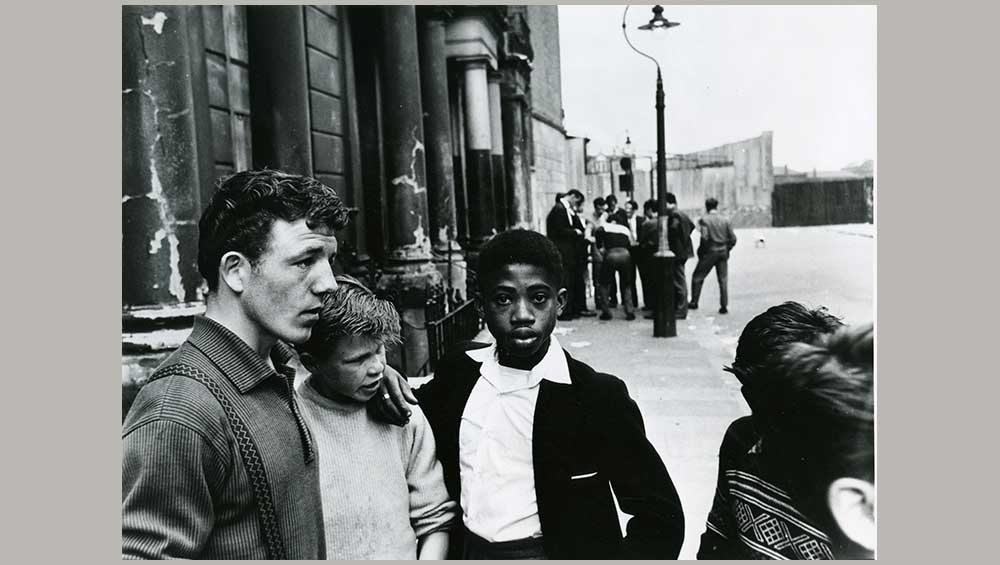
Roger Mayne. Men and Boys, Southam Street, London 1959. Vintage gelatin silver print, 18.5 x 27 cm. © Roger Mayne Archive / Mary Evans Picture Library.
The Courtauld, London
14 June – 1 September 2024
by BETH WILLIAMSON
The documentary images of photographer Roger Mayne (1929-2014) are the subject of the first ever exhibition of photography to take place in the main galleries of the Courtauld. Focusing on his unique way of capturing the youth of the day in the 1950s and 60s, the exhibition brings together his well-known photographs of Southam Street in west London, and others of that ilk, alongside some very special family photographs of his children growing up. With such a personal angle, it is crucial that the guest curator, Jane Alison, has worked closely with Mayne’s daughter, Katkin Tremayne, over several years to bring this passion project to fruition.
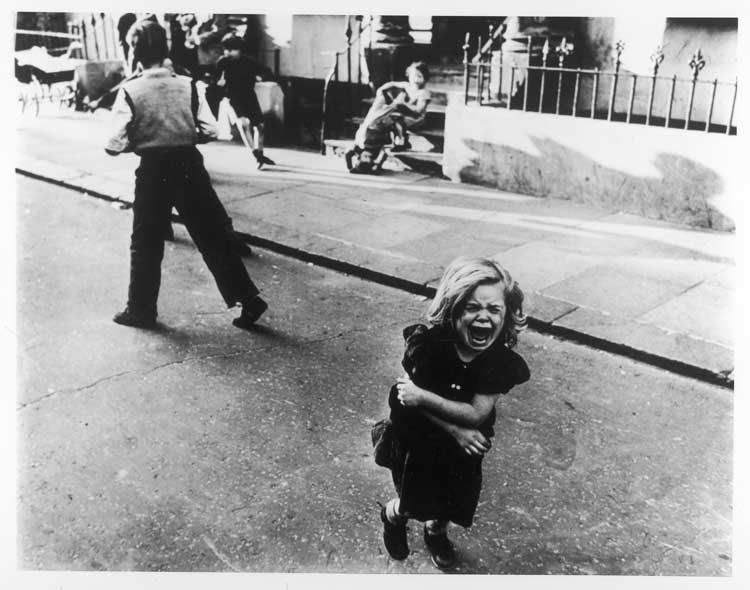
Roger Mayne. From the Southam Street Album 1956-61, 5 May 1956. Vintage gelatin silver print mounted in an album, 36.4 x 54.8 cm. Courtesy Victoria & Albert Museum.
Mayne never trained as a photographer. Rather, he stumbled on the medium while he was studying chemistry at Balliol College, Oxford. Moving to London in 1953, he found inspiration in the work of Nigel Henderson (1917-85) and others, photographing all human life in a way that he too found compelling. In postwar London and other cities around the United Kingdom and in Europe, Mayne set his photographic eye on the derelict streets and poverty-ridden communities, those with no voice or agency of their own. It was his repeated visits to Southam Street in Notting Hill that gained him recognition, a project to which he dedicated himself for a six-year period between 1956 and 1961. When his Portrait of Southam Street was published in the short-lived magazine Uppercase, edited by Theo Crosby, in 1961, his photographs occupied about half the issue. Still, Mayne felt he occupied an unfashionable position between two extremes – the abstract and the social-realist. For him, the social-realist photographers imposed preconceived moral or political perspectives. His interest in Southam Street was neither of these things, but a genuine curiosity in the vitality of the people, especially the children, and what he saw as a positive way of life. He said his photographs were not a portrayal but a dramatisation of what he saw there. This makes sense when you realise that he understood Southam Street as an extraordinary place.
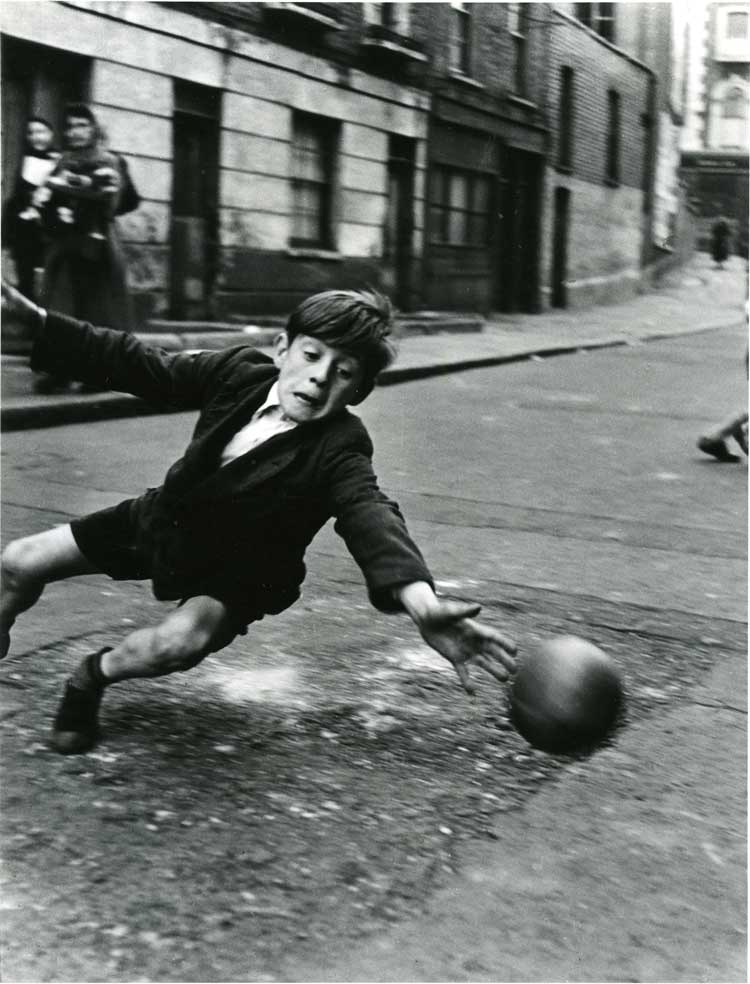
Roger Mayne. Goalie, Brindley Road 1956. Modern print (printed in 2002), 38 x 30 cm. © Roger Mayne Archive / Mary Evans Picture Library.
In his probing exploration of places and people, even within his own home and family, Mayne looked as much with the eye of an anthropologist as an artist. In this respect he was close to Henderson, who had also trained as a scientist, and had encouraged him to move to London. It was at about this time that Henderson was involved in the Parallel of Life and Art exhibition at the Institute of Contemporary Arts (11 September – 18 October 1953) in London. Early in his career, Henderson had taken photographs of children and young people playing in the streets of Bethnal Green in east London, where he was living with his wife Judith Stephen. Stephen had been involved in an anthropological study of the area since 1945 and her approach seeped into Henderson’s practice and, subsequently, Mayne’s.
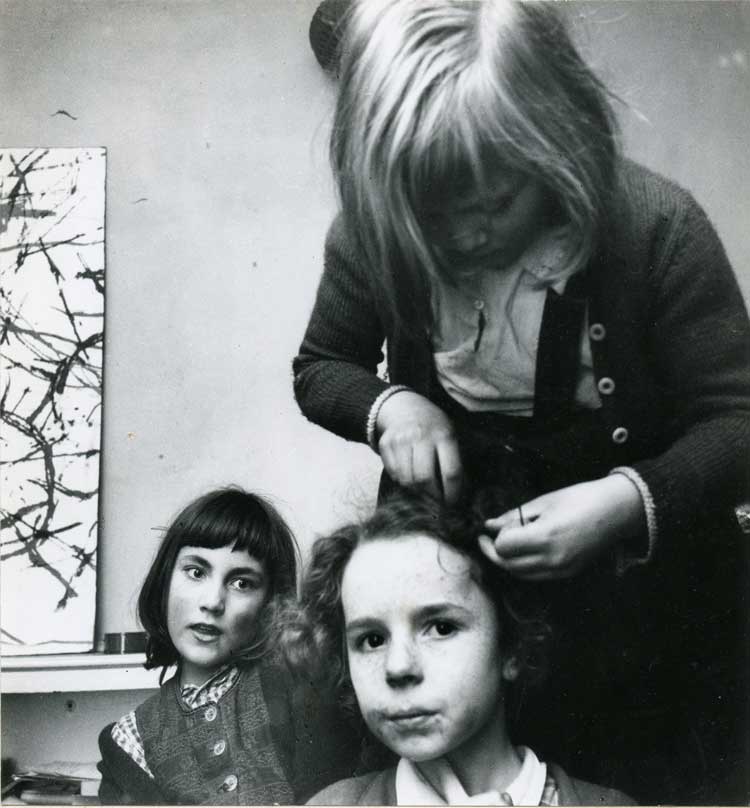
Roger Mayne. Three children at Nigel Henderson’s: Drusilla (Jo) and Justin Henderson, with a friend, Bethnal Green 1953. Vintage gelatin silver print, 21 x 20 cm. © Roger Mayne Archive / Mary Evans Picture Library.
In the photograph Three Children at Nigel Henderson’s: Drusilla (Jo) and Justin Henderson, with a friend, Bethnal Green (1953), for instance, Mayne seems less concerned with producing a conventional portrait of the children than capturing the dynamic between them. Like much of his street photography, this indoor shot of three children contains an energy and vitality conveyed through the tilt of a head, the activity of the hands and the intensity of focus. Here, too, there is a kind of choreography at play between the various figures in the photograph, coalescing the composition while creating the potential for everything to fall apart in an instant. In the milieu of postwar Britain, life was precarious, off-balance and ungrounded, and that is what Mayne captured in his photographs. Still, young people were modern and fashionable, agents of their own lives and carving out their own identities. One of his best-known photographs A Girl Jiving in Southam Street (Eileen Sheekey), London (1957) is a highlight of the exhibition, but there are many unexpected pleasures too.
,-London,-1957-Courtesy-Victoria-and-Albert-Museum.jpg)
Roger Mayne. Girl Jiving in Southam Street (Eileen Sheekey), London 1957. Vintage gelatin silver print, 36.5 x 25.2 cm. Courtesy Victoria & Albert Museum.
When Mayne married the playwright Ann Jellicoe in 1962, they honeymooned in Spain and he began a new strand of image making, shooting 50 rolls of film, taking pictures which, he felt, were the best he had ever taken. The arresting qualities of the few large-scale images he had printed on board, very few of which still exist, should not go unmentioned. These include Girl, Almunecar (1962), focusing on a single figure lost in thought. When his own children were born and the family moved to Dorset in the mid-60s, Mayne’s imagery changed once again. Now focused on his growing family, Mayne took some of his most intimate pictures yet, including some astonishing shots of his daughter being born.
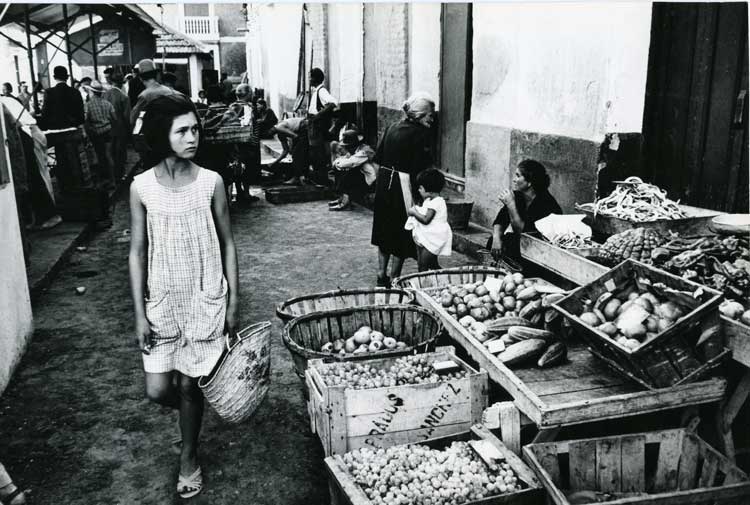
Roger Mayne. Girl, Almunecar 1962. Vintage gelatin silver print mounted on board, 59.5 x 91.5 cm. © Roger Mayne Archive / Mary Evans Picture Library.
After the arrival of Katkin in 1966 and Tom in 1969, the family left Rose Cottage in Dorset and moved to Lyme Regis in 1975. The warmth and humour with which he photographed his growing family at this time echoes that with which he had photographed the Henderson family in the 50s. A late group of works show his granddaughter Zoe in a similar vein. A wonderful collage of images Zoe, Katkin, Ann and David (1993), shows three generations of women in Mayne’s life. More importantly, is the unifying theme of the images, all of which deal with play and creativity, a theme that endured throughout his practice from Southam Street days onward. Whether drawing on pavements, playing football, or skipping or dancing to music, these playful and almost choreographed actions were central to Mayne’s understanding of life in his street photography. In his family photographs it is a more intimate form of playing together that emerges, still imbued with a gentle anthropological curiosity, something that shines through in this exhibition and something that never left him.